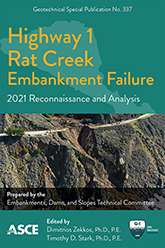New ASCE Publication Analyzes Recent Embankment Failure in Northern California

Reston, Va. – In January 2021, a mudslide took out part of the California Coastal Highway near Big Sur. The Embankments, Dams, and Slopes Technical Committee of the Technical Coordination Council of the Geo-Institute of ASCE mobilized a team to investigate the disaster. This latest Geotechnical Special Publication (GSP) from American Society of Civil Engineers (ASCE), Highway 1 Rat Creek Embankment Failure: 2021 Reconnaissance and Analysis, GSP 337, provides an overview of the reconnaissance and analysis done of the embankment failure caused by Rat Creek.
The report begins with a historical and geological overview of this stretch of highway along with a description of the embankment failure. Specific data collection activities such as terrestrial LiDAR and unmanned aerial vehicle (UAV) data acquisition, exposure mapping and sampling, radiocarbon dating of soil samples, precipitation and geospatial analyses, and satellite-based assessments, used by the investigative team, are outlined in the book. GSP 337 concludes with the roadway repair and recommendations to avoid future embankment erosion.
Civil engineers interested in designing and constructing resilient infrastructure to accommodate future extreme events will benefit from this case study showcasing a failure of US infrastructure in the face of climate change and cascading natural disasters.
To purchase online, visit the ASCE Bookstore
Limited review copies are available for book reviews. Please contact Leslie Connelly, [email protected].
ABOUT THE AMERICAN SOCIETY OF CIVIL ENGINEERS
Founded in 1852, the American Society of Civil Engineers represents more than 150,000 civil engineers worldwide and is America’s oldest national engineering society. ASCE works to raise awareness of the need to maintain and modernize the nation’s infrastructure using sustainable and resilient practices, advocates for increasing and optimizing investment in infrastructure, and improve engineering knowledge and competency.


